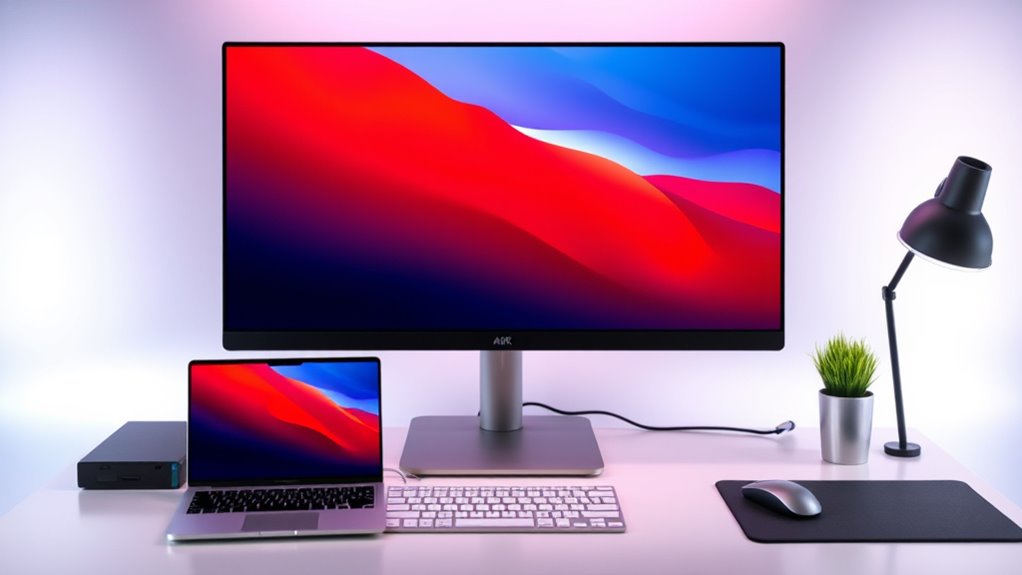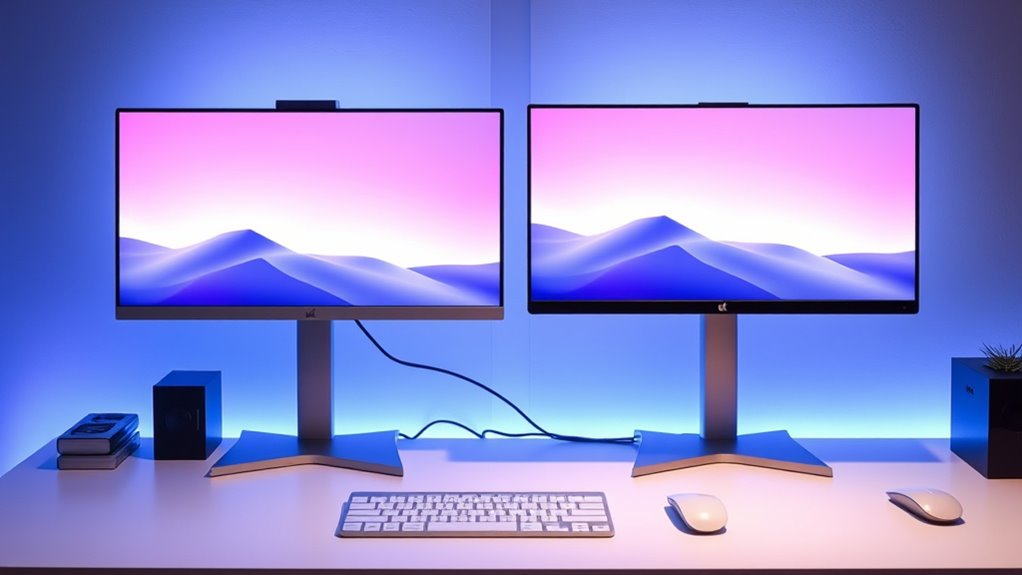If you’re looking for the best USB-C monitors for MacBook in 2025, I recommend the MNN 15.6-inch FHD Portable Monitor for portability and quick setup, and the Dell 34 Plus USB-C Curved Monitor for professional work and color accuracy. Both support high-resolution displays, HDR, and seamless USB-C connectivity, ensuring compatibility with macOS. Want to discover how to choose the perfect monitor for your needs and budget? Keep exploring for more insights.
Key Takeaways
- Prioritize monitors with Thunderbolt 3/4 or USB-C ports supporting high data transfer, video output, and ≥85W power delivery for seamless MacBook compatibility.
- Select displays with high resolutions (e.g., 1920×1080, 3440×1440, or 4K) and wide color coverage (sRGB, DCI-P3) for vibrant, accurate visuals.
- Ensure monitors feature HDR support, blue light reduction, and flicker-free technology for eye comfort during extended use.
- Opt for portable options like 15.6-inch models with smart covers or integrated stands that balance workspace and mobility.
- Consider future-proof features such as multiple USB-C ports, high refresh rates, and macOS compatibility to maximize investment longevity.
MNN 15.6-inch FHD Portable Monitor with USB C HDMI and Smart Cover
If you’re looking for a portable monitor that seamlessly complements your MacBook, the MNN 15.6-inch FHD Portable Monitor is an excellent choice. It boasts a 1920×1080 resolution with an advanced IPS matte screen, delivering vibrant colors and detailed visuals from any angle. HDR mode enhances brightness and color depth for immersive gaming and media. The monitor reduces blue light and flickering, protecting your eyes during long sessions. With two full-feature USB-C ports, it supports plug-and-play connection to laptops, phones, and gaming consoles. Its ultra-slim, lightweight design makes it perfect for travel, while the smart cover doubles as a stand, offering versatile positioning in portrait or landscape mode.
Best For: users seeking a portable, high-quality display that easily connects to laptops, gaming consoles, and smartphones for work or entertainment on the go.
Pros:
- High-resolution 1920×1080 IPS matte screen with wide 178° viewing angle for vibrant, detailed visuals
- Supports multiple display modes including extend and portrait, boosting productivity and versatility
- Compact, lightweight design with a smart cover that doubles as a stand, ideal for travel and mobile use
Cons:
- Requires compatible USB-C cables and devices supporting Thunderbolt 3.0 or USB 3.1 DP ALT-MODE for optimal performance
- HDR mode may not be available on all devices or in all applications
- Limited to 15.6 inches, which may be small for users needing larger screens
Dell 34 Plus USB-C Curved Monitor (S3425DW)
The Dell 34 Plus USB-C Curved Monitor (S3425DW) stands out as an ideal choice for MacBook users who want a seamless, clutter-free setup. Its 34-inch curved VA panel delivers sharp 3440 x 1440 resolution with vibrant colors, thanks to 99% sRGB and 95% DCI-P3 coverage. The HDR support adds depth and realism, while the 120Hz refresh rate and fast response time guarantee smooth visuals. With a single USB-C connection supporting data, video, and up to 65W power, it keeps your workspace tidy. Plus, features like ComfortView Plus and enhanced audio make it perfect for all-day use, blending performance with convenience.
Best For: MacBook users seeking a high-quality, clutter-free, and versatile monitor with excellent color accuracy and smooth visuals.
Pros:
- Vibrant color coverage with 99% sRGB and 95% DCI-P3 for rich visuals
- Single USB-C cable supports data, video, and up to 65W power delivery, reducing clutter
- HDR support and fast 120Hz refresh rate ensure smooth and realistic images
Cons:
- 34-inch size may be too large for small workspaces
- Limited to 3440 x 1440 resolution, not 4K for ultra-high detail
- Built-in speakers may not replace dedicated audio equipment for audiophiles
Factors to Consider When Choosing USB-C Monitors for Macbook

When choosing a USB-C monitor for my MacBook, I focus on compatibility and connectivity to guarantee seamless use. I also consider display resolution and eye comfort features for a better viewing experience. Finally, I evaluate port options, portability, and size to match my workspace and lifestyle needs.
Compatibility and Connectivity
Choosing the right USB-C monitor for your MacBook hinges on guaranteeing seamless compatibility and reliable connectivity. First, check that the monitor’s USB-C port supports Thunderbolt 3.0 or USB 3.1 with DP Alt Mode, guaranteeing full compatibility with MacBook devices. It’s also essential that the monitor can transmit both power and video signals through a single USB-C cable, simplifying your setup. Confirm that the monitor is compatible with macOS to prevent driver issues or glitches. Additionally, verify that it delivers sufficient power—ideally 60W or more—to keep your MacBook charged during use. Finally, review the port specifications carefully, ensuring the monitor’s USB-C features match your specific MacBook model and workflow requirements. This way, you ensure a smooth, efficient connection every time.
Display Resolution Quality
A monitor’s display resolution considerably influences how sharp and detailed your visuals appear on your MacBook. Higher resolutions, like 1920×1080 or 3440×1440, provide clearer, more precise images, making your work and entertainment more enjoyable. For professional editing and content creation, 4K resolution (3840×2160) offers ultra-clear visuals that help you see every detail. Color accuracy and coverage, measured in sRGB or DCI-P3 percentages, also impact image quality, making colors more realistic. Monitors with IPS or VA panels deliver better color consistency and wider viewing angles, enhancing the overall resolution quality. Additionally, HDR support adds contrast and vibrancy, making images pop with depth and realism. Choosing a monitor with the right resolution guarantees your MacBook’s display is as sharp and accurate as possible.
Eye Comfort Features
Eye comfort features are essential to contemplate because prolonged screen time can cause eye strain and fatigue. I look for monitors with blue light reduction technology, like low blue light modes or flicker-free screens, to ease eye discomfort during long work sessions. High-resolution displays, such as Full HD or higher, combined with wide viewing angles, ensure sharp visuals and reduce the need to squint or strain. I also favor IPS panels for accurate colors and consistent image quality from different angles. Adjustable brightness and contrast settings help me tailor the display to my environment, preventing glare and eye fatigue. Additionally, anti-glare matte coatings are a must in bright rooms, as they cut reflections and make viewing more comfortable over extended periods.
Port Selection Options
When selecting a USB-C monitor for my MacBook, I prioritize ports that support data transfer, video output, and power delivery to streamline my setup. I look for USB-C ports that support Thunderbolt 3 or 4, maximizing data speed and compatibility with my MacBook’s capabilities. Having multiple USB-C ports is a bonus, as it allows me to connect peripherals without extra hubs or adapters. I also check that the port can deliver at least 85W of power to charge my MacBook while connected, reducing cable clutter. Finally, I verify the port supports DisplayPort Alt Mode for high-resolution video and audio, ensuring crisp, seamless output. These factors help me create a clean, efficient workspace with reliable, versatile connectivity.
Portability and Size
Choosing the right USB-C monitor for my MacBook often comes down to portability and size, especially if I need a setup that’s easy to carry around. Portable monitors usually range from 13 to 17 inches, making them convenient for on-the-go use. A 15.6-inch model strikes a good balance between screen space and lightweight design, perfect for travel. Ultra-slim monitors with minimal thickness fit comfortably in backpacks or briefcases, enhancing mobility. Smaller options tend to have fewer ports but are lighter and quicker to set up. On the other hand, larger portable displays like 17 inches offer more workspace but can be bulkier, which might compromise portability. Ultimately, I look for a size that fits my workflow and travel needs without sacrificing convenience.
Price and Budget
Price and budget considerably influence the selection of a USB-C monitor for my MacBook. Monitors range from under $200 to over $1,000, so setting a realistic budget is essential. Cheaper options might save money upfront but often compromise on resolution, color accuracy, or build quality. On the other hand, investing a bit more can provide better compatibility, durability, and future-proofing, ensuring the monitor keeps up with my needs. I compare features within my price range, like HDR support, refresh rate, and connectivity options, to get the best value. Knowing my budget helps me narrow down choices quickly and focus on monitors that balance performance and cost. This approach makes selecting a monitor more straightforward and aligned with my expectations.
Frequently Asked Questions
How Do USB-C Monitors Impact Macbook Battery Life?
Using a USB-C monitor can impact my MacBook’s battery life by increasing power consumption, especially if I’m running high-resolution displays or using features like HDR. However, since USB-C supplies power, I often connect my MacBook to the monitor to charge it simultaneously. While this setup might drain my battery faster during intensive tasks, it’s convenient because I keep my workspace tidy and maintain power without extra cables.
Are There Any Compatibility Issues With Older Macbook Models?
Yes, there can be compatibility issues with older MacBook models. Some may lack the necessary USB-C ports or support certain features like Power Delivery or high-resolution displays. I’ve experienced this firsthand, where older Macs struggle with newer monitors. To avoid frustration, I recommend checking your MacBook’s specifications and ensuring the monitor’s compatibility before buying. Sometimes, using adapters helps, but not always.
What Is the Typical Lifespan of a USB-C Monitor for Macbooks?
While no device lasts forever, a USB-C monitor for MacBooks typically offers about 5 to 8 years of reliable service if well cared for. I’ve found that with proper maintenance, like avoiding power surges and keeping firmware updated, these monitors can gracefully serve through multiple MacBook upgrades. Ultimately, technology evolves, but investing in quality can extend your monitor’s useful life, making it a worthwhile addition to your setup.
Can USB-C Monitors Support Multiple Displays Simultaneously?
Yes, USB-C monitors can support multiple displays simultaneously, especially if they have multiple Thunderbolt or USB-C ports. I’ve used setups where I connect my MacBook to two or more monitors via a single USB-C hub or dock, creating a seamless multi-screen experience. Just make certain the monitor and your MacBook support daisy-chaining or multiple outputs, and you’ll enjoy a smooth, expanded workspace without fuss.
How Do USB-C Monitors Affect Macbook Performance During Intensive Tasks?
Using a USB-C monitor generally keeps my MacBook performing smoothly, even during intensive tasks. It’s like adding a helpful assistant—there might be slight delays if I push the system too hard, but overall, the impact is minimal. I find that high-quality monitors with good bandwidth support make a noticeable difference, ensuring my workflow stays seamless without sacrificing performance. It’s a balanced setup that keeps me productive and happy.
Conclusion
Choosing the right USB-C monitor for your MacBook isn’t just about specs; it’s about enhancing your entire experience. Whether you prioritize portability or a larger, immersive display, the right monitor makes all the difference. So, why settle for less when you can upgrade your setup for seamless work and play? Invest wisely, and let your MacBook shine with a monitor that truly complements it. Ready to elevate your workspace?












